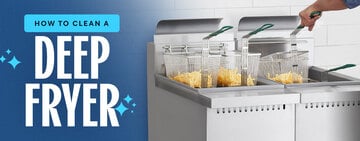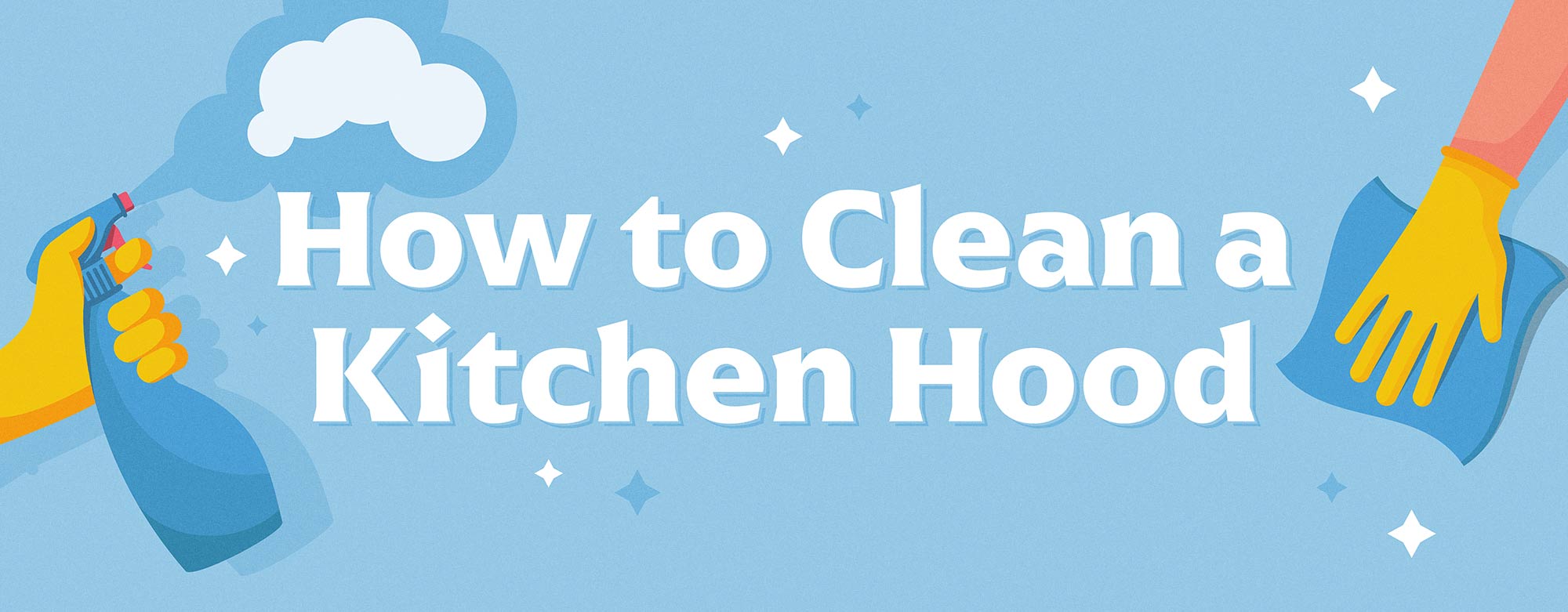
How to Clean a Kitchen Hood
Last updated on 11/17/2021Kitchen hoods are a key part of any restaurant, helping to ventilate your workplace and remove hazardous particles from the air. Because of their importance in the kitchen, keeping your hood systems in working condition is imperative to your safety and success. Along with regular maintenance checks, making an effort to keep your hoods clean can help to ensure they stay in working condition. If you’re unfamiliar with how to clean a kitchen hood, this article will teach you how to do it properly.
Commercial Hood Cleaning
Keeping your kitchen hoods clean is an important way to maintain a healthy, safe, and functional workplace. If grease or other contaminants are allowed to build up in your hood system, you may experience an increased risk of fires, improper ventilation, and even unpleasant odors in your kitchen. For this reason, you must schedule regular cleaning for each hood you own. Keep in mind that since a hood system is comprised of a variety of parts, each one must be cleaned separately to ensure the job is done correctly. To learn how to clean your kitchen hoods, grease traps, and filters, continue reading below.
Exhaust Hood Cleaning
An exhaust hood helps to draw smoke, fumes, and other particles in the air out of your kitchen. Over time, these particles can build up in your hood system, resulting in a need to have it cleaned. Use the following instructions to learn how to clean an exhaust hood:
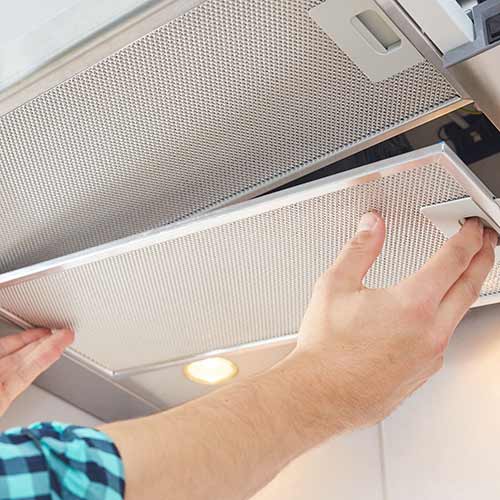
- Remove any additional components: To best clean your kitchen hood, be sure to remove any grease traps, filters, and fans to ensure each component is cleaned separately.
- Mix cleaning solution: In a bucket, prepare a solution of warm water and liquid degreaser.
- Scrub interior: Using the solution, scrub the interior of the hood using a non-abrasive scrub pad, soft-bristle brush, or cloth. Be sure to remove any grease or additional debris.
- Wipe interior: After scrubbing, wipe the interior using a damp cloth to remove any soapy residue. Afterward, use a separate towel to dry the interior.
- Scrub exterior: Using the cleaning solution, scrub the exterior of the hood to remove any excess grease.
- Wipe exterior: Remove any additional soap residue with a damp cloth. Dry the exterior using a separate towel.
- Dry: Give your kitchen hood additional time to air dry.
How to Clean Grease Trap Screens in Range Hoods
Grease traps are designed to keep fats, oils, and other greasy substances from entering your building’s ventilation or sewage system. If they begin to overflow, your hood system may begin to fail. The size of your grease traps can affect how often they need to be cleaned. Adhere to the following steps to keep them in good condition:
- Remove grease traps: Remove the grease traps from your range hood.
- Remove grease: Proceed to remove as much grease from them as you can. Be sure to place the grease in a separate container and refrain from rinsing it down a drain.
- Eliminate remnants: Using a non-abrasive scrubbing pad or soft bristle brush, scrub any remaining grease from the traps.
- Prepare degreasing solution: Using warm water and a liquid degreaser, create a cleaning solution in your sink. Be sure to check your degreaser bottle to find the appropriate water ratio.
- Soak traps: Once the sink has been prepared, soak your grease traps in the solution.
- Remove traps from solution: After waiting 5-10 minutes, remove the traps from the sink.
- Dry: Allow your grease traps to air dry before re-installing them in your kitchen hood.
Kitchen Hood Filter Cleaning
Cleaning your kitchen hood filters ensures that your system can correctly filter the air in your kitchen. As air is pushed through your hood system, these filters work to catch particles in the air and prevent them from being recycled back into the kitchen. Because of this, they can quickly become caked with grease and grime. To learn how to clean kitchen hood filters, follow the steps below:
- Remove filters: Take the air filters out of your range hood to clean them.
- Mix degreasing solution: In a sink or large tub, mix a solution of warm water and liquid degreaser. Be sure to check the bottle for the appropriate ratio of water.
- Soak filters: Place the filters in the water to soak. Since there is a chance the filters attract additional grease, consider allowing them to soak for 2-3 hours or even overnight.
- Remove filters from solution: After allowing them to soak, remove the filters from your cleaning solution.
- Scrub filters: Using a soft cloth, lightly scrub any additional residue from the filters and run them through the water to rinse any remnants.
- Dry: Allow the filters to air dry before reinstalling them in your kitchen hood.
How to Clean Kitchen Hood Fans
Sometimes referred to as blowers, a kitchen hood exhaust fan draws air into the hood. Not only do these fans help to maintain an even distribution and flow of air, but they also are the key component working to capture grease particles, smoke, and fumes as you cook. Depending on the type of hood you own, there may be as few as two fans, although many hoods are designed with more. To clean your kitchen hood fans, follow the steps below:
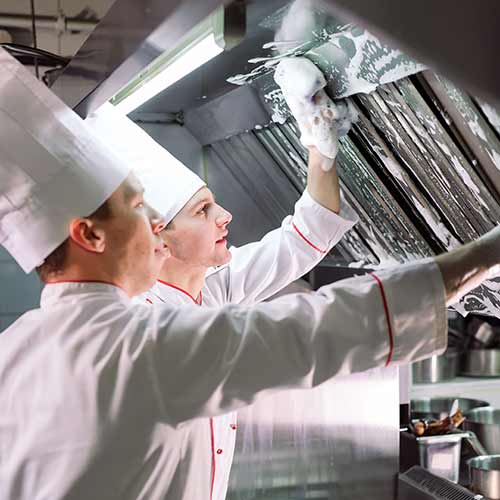
- Remove fan: To start cleaning your fan, detach and remove it from the kitchen hood.
- Remove fan blade cover: Once the blower has been removed, detach the fan blade cover using a drill. This gives you access to the individual fan blades.
- Detach fan blades: Remove each fan blade so that they can be washed individually. If your hood uses multiple fans, be sure to make a distinction between which fan is which.
- Soak blades: Submerge the fan blades in warm water with soap and allow them to soak.
- Dry: Once the fan blades have had time to soak, remove them from the water and allow them to dry. Consider using a microfiber cloth or letting them air dry.
- Reattach fan blades: After they’ve had time to dry, reattach the fan blades.
- Replace blower: Place the blower back in the kitchen hood and re-install it.
How to Clean Kitchen Hood Ducts
Although some ductwork extends beyond the range that you can comfortably clean it, there will likely be some exposed ducts to work on. If need be, consider having your ducts professionally cleaned by a team with the necessary training and knowledge. However, to clean exposed ducts within reach, follow these steps:
- Mix cleaning solution: Prepare a cleaning solution from warm water and liquid degreaser in a bucket or similar container.
- Scrub duct interior: With a non-abrasive scrubbing pad or soft-bristle brush, scrub the interior of the exposed duct.
- Scrub duct exterior: With the same pad or brush, scrub the exterior of the exposed duct.
- Dry: Once you’ve finished cleaning, allow the duct to dry.
Kitchen Hood Cleaning Services
If you’re unsure whether you want to clean your hood system yourself, consider hiring a kitchen hood cleaning service to do it for you. These services, which can vary in availability depending on your location, allow you to have your hood system cleaned by a team of professionals. Although it can be costly, professional cleaning may be the right choice depending on your preferences.
Kitchen Hood Cleaning Cost
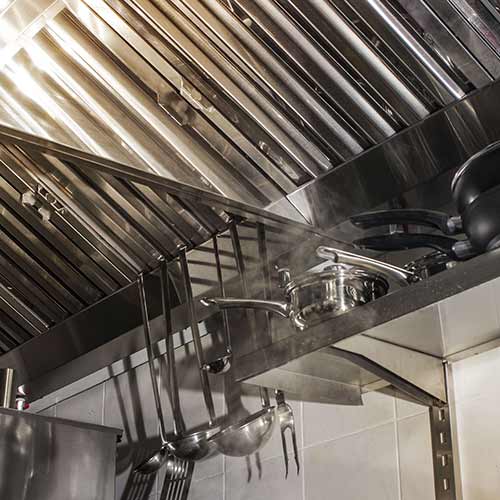
Although the cost varies depending on the service you hire and how much work needs to be done, most businesses pay somewhere between $300 and $600 to have their kitchen hoods cleaned. In some cases, the cleaning process can take upwards of four hours. Some factors that might influence the cost and amount of time required to have your kitchen hood professionally cleaned include:
- Crew size
- Location
- Hood system size
- Water availability
- Hood system configuration
- Hood condition
How Often Should You Clean a Kitchen Hood?
In general, it’s said that you should plan to clean your kitchen hood once every three months. However, this number doesn't apply to everyone. It’s important to note that the length of time you can go without cleaning your hood depends on several different factors, each of which can have a different effect on your cleaning schedule. Some of the most significant factors include:
- Business volume: A busy restaurant results in a busy kitchen, in turn causing more stress on your kitchen hoods. Conversely, if you cook less frequently or are only open on certain days of the week, you may not need to worry about your kitchen hoods as much.
- Menu items: A menu with an abundance of greasy foods or foods that result in excess steam while cooked means that your kitchen hoods will be used more frequently and need to be cleaned frequently.
- Type of equipment: Although some appliances are exempt, most kitchen hood code regulations require that all appliances be placed under a hood. Remember to take into account what kind of equipment you use and if it can cause additional dirt or grease to build up in your hoods.
To learn more about how often you should clean the different parts of your kitchen, consider reading our restaurant cleaning checklist.
Back to Top
Cleaning your kitchen hoods should be a regular occurrence in your restaurant and something that you take care to schedule regularly. Whether you’re hiring a service to do it for you or making an effort to clean them yourselves, keeping your hood systems clean helps to facilitate a safe and healthy environment for yourself, your guests, and your staff.


